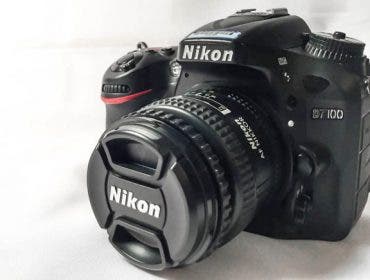This review was very hard to be objective about. You see, I’ve been waiting impatiently for Nikon to release a new 35mm f/1.4 lens for more than five years.
At first glance, one would think that the increasingly light-sensitive sensors of the latest wave of DSLRs would kill off demand for fast primes, but the reverse has been true, and the reasons are simple. Having the option for limited depth-of-field combined with as much light sensitivity as possible is great, and now there’s not nearly so much guesswork about “was that shot actually in focus or not?” There are a lot more choices now than “f/8 and be there.”
 I was clearly excited about the arrival of the new Nikon 35mm f/1.4 lens—so much so that my non-photographer girlfriend asked me, “What’s so special about this lens?”
I was clearly excited about the arrival of the new Nikon 35mm f/1.4 lens—so much so that my non-photographer girlfriend asked me, “What’s so special about this lens?”
The answer is: Nothing, in a way. 35mm is a pretty unexciting focal length, on its face. Slightly wide, it doesn’t have the warped-corner look of an ultra-wide. It doesn’t have the instant eye-candy look of an exotic telephoto lens. It’s just a workhorse focal length that strips everything down and focuses on content, and for general coverage, it is well-paired with moderate telephoto lenses like an 85mm f/1.4 or 70-200mm f/2.8.
To me it seemed strange that Nikon hadn’t made a professional lens in this focal length since 1981, and that one wasn’t regarded as one of their best lenses. So, there a lot of anticipation here to fill, especially since the new lens, at $1800, isn’t cheap, especially when you can get a full-frame 35mm f/2 for $360, or a DX 35mm f/1.8 for under $200.
Can it live up to the hype? For most users, no. If you’re using an entry-level DX camera because that’s where your budget is, buy the 35mm f/1.8 for one-ninth the price. You’ll love it, and if you get into hefty full-frame gear later, you can always sell it for almost the same price.
For me? The lens is not 100 percent perfect, but I am thrilled. And here’s why:
Build: Not everyone likes the hard plastic build of modern Nikon professional lenses, but to me it creates an attractive, sturdy package. The lens hood is nice and stiff and easily reversible. And it’s big—almost as big as the 24mm f/1.4 and 85mm f/1.4 lenses in the same family. For lots of people, this will be kind of a shame because a 35mm is a great walk-around focal length, and this is really bulky for a lens to carry all day every day. I mostly use these lenses on professional shoots with giant D3s cameras, so for me it’s not quite big enough because I prefer native 77mm filters on my lenses, instead of the 67mm ring this has. But that’s what step-up rings are for.
Image Quality: Extremely good, but not an absolute resolution champ. (DxO lab test results are not in yet.) Based on my using this lens in the field, it really seems like it was optimized for wide-open performance, so the difference between wide-open and middle-apertures is not as great as with most lenses—f/1.4 is really sharp, and f/8 is just a bit more sharp, but you can find sharper lenses if you look hard. It’s great for me, because if I paid for an f/1.4 lens I want to use it near-wide-open unless I have a good reason not to, but there are easier choices for landscape and studio shooters.
Here’s a comparison at f/8 and f/1.4, which also shows the good close-focus this lens features:

The bokeh is as good as I have come to expect from recent Nikon lenses. Nice transitions, good highlights:

Example of good foreground bokeh, also a lack of flare despite multiple light sources:

Autofocs: Users expecting the same lightning speed of the Canon 35mm f/1.4L will be disappointed at first—like the new Nikon 24mm and 85mm f/1.4s, this is not a speed champ, being just a bit faster than the 24. But it’s very accurate, even at wide apertures, and is noticeably more so in difficult focusing situations than the 24mm f/1.4 (which I also love, despite its trickiness). I could see right away that it was much easier to get in-focus f/1.4 shots on a dark dance floor with this than with the 24, though not quite as easy as the ludicrously fast-and-accurate 24-70mm f/2.8. I came to trust it pretty quickly.
NOTE: My copy needed serious AF micro-adjustment, about -15. This was not true of my 24G or 85G, but has been true of other lenses like the 135mm f/2. Be sure to test your lenses thoroughly. Micro-adjustment is the best feature invented for cameras since digital sensors.

Even in the near-darkness of ISO 12,800 at f/1.4, it was able to lock on well:

Speaking of ISO 12,800, this next one shows why we have f/1.4 lenses in the first place. The Church of San Frediano in Lucca, Tuscany is absolutely gorgeous, but to protect the art, much of it is too dark to make out with the naked eye. This part of the ceiling, captured at 1/15th, ISO 12,800, f/1.4, was almost black to my eye. I would have needed a tripod to capture it otherwise.

Final verdict: This is going to be an extremely valuable part of my bag, and it was well worth the cost. Now that this is a new year, I will be restarting the Photo of the Day archive, and keep an eye out for lots of photos taken with the 35 there.
More Photos at f/1.4:


Great handling of backlight


Lastly, here’s one for full-res download, with all the bokeh you can handle. Click for full-size:
Connect with the Adorama Learning Center on Facebook or Twitter.





